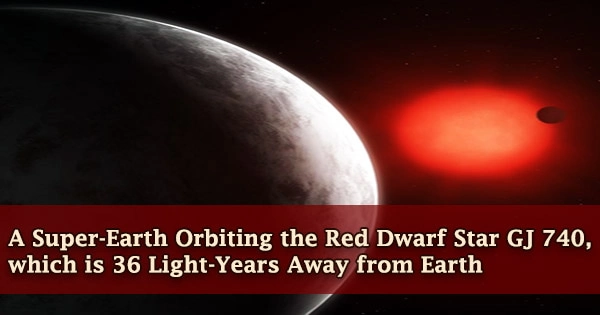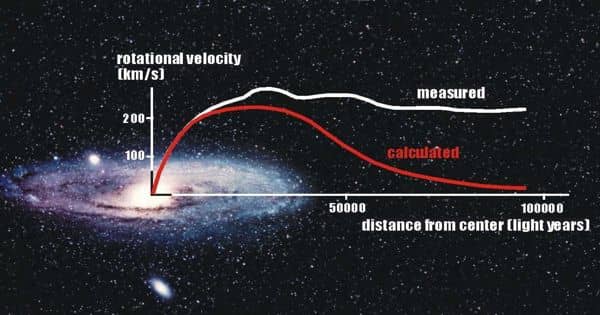Exoplanets in orbit around red dwarf stars have been studied extensively in recent years in order to locate exoplanets. The effective surface temperatures of these stars range from 2400 to 3700 K (nearly 2000 degrees colder than the Sun), while their masses range from 0.08 to 0.45 solar masses.
In this regard, a team of researchers led by Borja Toledo Padrón, a Severo Ochoa-La Caixa doctorate student at the Instituto de Astrofísica de Canarias (IAC), has identified a super-Earth circling the star GJ 740, a red dwarf star 36 light-years from Earth.
The planet has a 2.4-day orbital period around its star, and its mass is around three times that of Earth. Because the star is so near to the Sun, and the planet is so close to the star, this new super-Earth may be the subject of future investigation using extremely big diameter telescopes by the end of the decade. The study’s findings were published in the journal Astronomy & Astrophysics recently.
Red dwarf stars, commonly known as M dwarfs or M-type stars, are the most common and smallest kind of hydrogen-burning stars in the universe. The masses of red dwarf stars range from 0.08 to 0.6 times that of the Sun. Red dwarfs are the most common form of a star because lighter stars are significantly more frequent than heavy stars. About three-quarters of the stars in the Milky Way Galaxy are red dwarfs. In elliptical galaxies, the percentage is considerably larger.

“This is the planet with the second shortest orbital period around this type of star. The mass and the period suggest a rocky planet, with a radius of around 1.4 Earth radii, which could be confirmed in future observations with the TESS satellite,” explains Borja Toledo Padrón, the first author of the article.
The data also point to the presence of a second planet with a 9-year orbital period and a mass comparable to Saturn’s (roughly 100 Earth masses), though its radial velocity signal could be due to the star’s magnetic cycle (similar to that of the Sun), necessitating more data to confirm that the signal is truly due to a planet.
The Kepler mission has discovered a total of 156 new planets around cool stars, making it one of the most successful in detecting exoplanets using the transit method (which is the search for small variations in the brightness of a star caused by the transit between it and ourselves of planets orbiting around it). Based on its statistics, this kind of star is thought to have an average of 2.5 planets with orbital periods of fewer than 200 days.
With a spectral class of M and a surface temperature of 2,000–3,500 K, red dwarfs are the coldest main-sequence stars. Because these stars are so cold, components like titanium oxide have strong spectral lines that would be disassociated in hotter stars. With luminosities ranging from 0.0001 to 0.1 times that of the Sun, red dwarfs are also the faintest stars.
“The search for new exoplanets around cool stars is driven by the smaller difference between the planet’s mass and the star’s mass compared with stars in warmer spectral classes (which facilitates the detection of the planets’ signals), as well as the large number of this type of stars in our Galaxy,” comments Borja Toledo Padrón.
Cool stars are also good candidates for planet searches using the radial velocity technique. This approach uses spectroscopic measurements to identify tiny changes in a star’s velocity caused by the gravitational attraction of a planet in orbit around it. Since the discovery of the first radial velocity signal of an exoplanet around a cool star in 1998, the radial velocity technique has been used to identify a total of 116 exoplanets around this type of stars.
Red dwarfs, on the other hand, are totally efficient and will burn through their whole supply of hydrogen due to convection. They will then get hotter and smaller, eventually transforming into blue dwarfs before dying as white dwarfs. The habitable zone of a red dwarf is relatively near to the star due to its low brightness. A planet in that area would orbit the red dwarf once every several weeks, transiting its star often.
“The main difficulty of this method is related to the intense magnetic activity of this type of stars, which can produce spectroscopic signals very similar to those due to an exoplanet,” says Jonay I. González Hernández, an IAC researcher who is a co-author of this article.
The research is part of the HADES (HArps-n red Dwarf Exoplanet Survey) project, in which the IAC collaborates with the Institut de Ciències de l’Espai (IEEC-CSIC) of Catalonia, and the Italian program GAPS (Global Architecture of Planetary Systems), whose goal is to detect and characterize exoplanets around cool stars, in which are being used HARPS-N, on the Telescopio Nazionale Galileo (TNG) at the Roque de los Muchachos Observatory (Garafía, La Palma).
A six-year observing campaign with HARPS-N, as well as measurements with the CARMENES spectrograph on the 3.5m telescope at the Calar Alto Observatory (Almera) and HARPS on the 3.6m telescope at the La Silla Observatory (Chile), as well as photometric support from the ASAP and EXORAP surveys, made this detection possible. IAC researchers Alejandro Suárez Mascareño and Rafael Rebolo are also involved in this project.
















